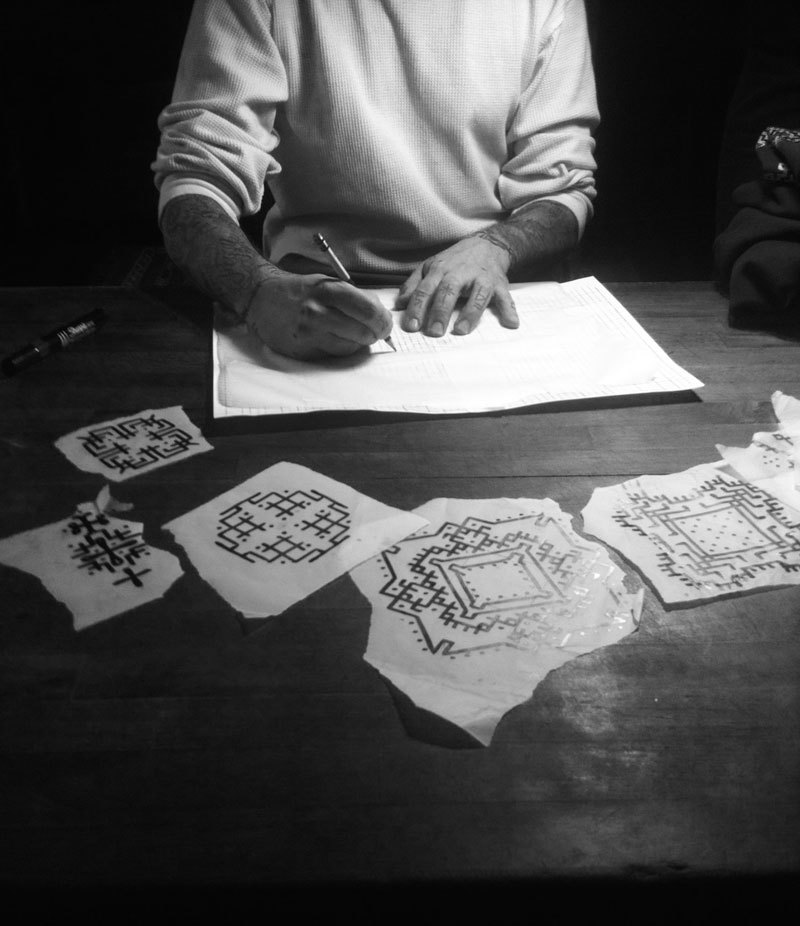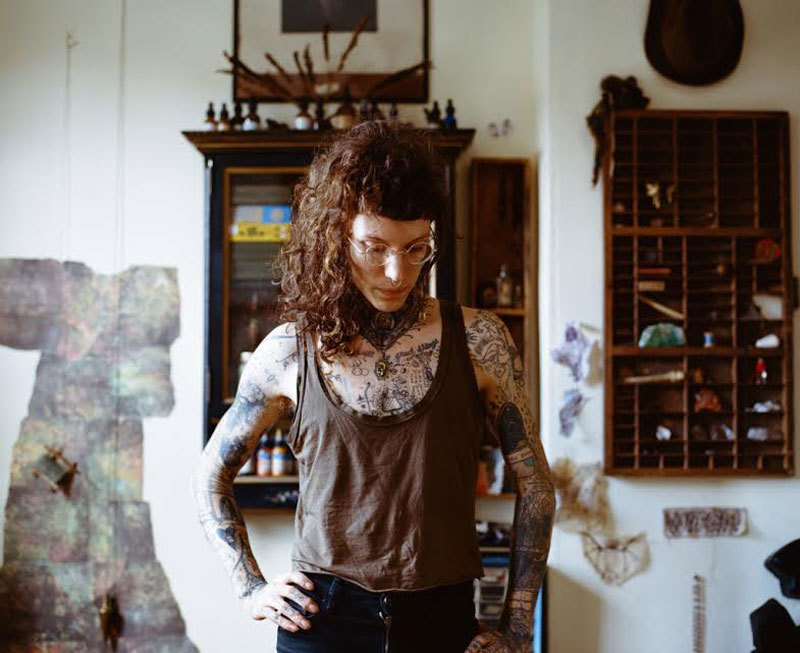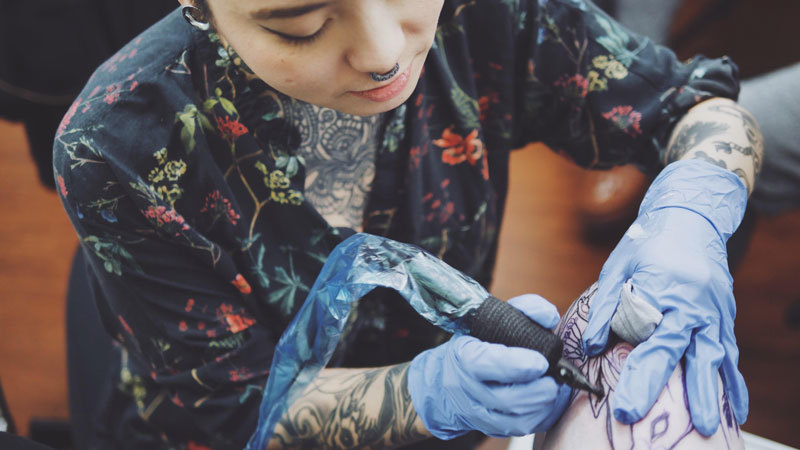When Canadian-born queer tattoo artist Brody Polinsky started his career he was in the closet. As an insecure young man, he didn’t feel he fit in with the subcultures he participated in. He was interested in punk and metal music, motorcycles, skateboarding and tattoos. With a history of hyper-masculinity and homophobia marring mainstream tattoo culture, his interests and identity were in conflict.
“My skin was a permanent mask which I wore to the best of my ability. Everyone was very shocked when I came out. That meant years of self-inflicted homophobia, with my chosen communities all using anti-gay language daily. Most of these people have no idea what hate speech does,” Polinsky recounts.
In 2002 Polinsky came out, over a decade later he started UNIV ERSE Studio in Berlin in 2016. UNIV ERSE is a queer-friendly space, employing a revolving stable of LGBTIQ+ tattoo artists. Before an appointment, clients join him for a one-on-one meeting at the studio over tea, he then creates a unique, custom-made design for the individual, which also takes into account their pain threshold. Polinsky’s work features shapes and lines and are heavy on geometric detail. No two designs are the same.
Because of people like Polinsky, the perception of tattoo culture in the western world has shifted in recent years. What was initially traditional, exclusive, and somewhat uniform has given way to a broader spectrum of self-expression. And as tattoos become more and more commonplace, queer artists are finding ways to use the practice to create spaces for themselves and their clients.

Polinsky was inspired by this climate to start UNIV ERSE, but he was also responding to negative experiences he’d had working at various studios around the world. He often felt spaces to be generally unsafe for queer folk, resulting in uncomfortable and hurtful situations. “I have a thick skin and am pretty desensitised to homophobic derogatory speech. But the real problem is if I have a queer client and people make them feel on edge. It’s hard to control [the behaviour of] other tattooers’ clients or the tattooers themselves in a busy shop,” he explains. Adding, “These attitudes also result in queer tattooers not wanting to put themselves through a traditional apprenticeship process due to fear of the industry.”
Some of these tattoo artists have “sort of snuck in through the back”, as queer trans woman and tattooer Noel’le Longhaul explains. She started out tattooing herself and her friends, which resulted in word-of-mouth recommendations and greater visibility through social media. Longhaul is now licensed, and works almost exclusively with queer and trans clients. “Starting to find queer elders in the tattoo world has been incredibly affirming and opened up unseen possibilities for me to humble myself to the knowledge and skill of those more experienced than me. I feel for the first time that I’m not totally alone in an anomalous practice,” she tells i-D.
Adam Traves of Disinhibition shares a similar trajectory: he got started when a friend handed down their old tattoo machine, and taught himself through trial-and-error, relying heavily on the internet for help. Later on, he found work at Crucible Tattoo Co, a queer-run, queer-owned shop in Melbourne where his sexuality as a queer man has never been an issue. His designs are often overtly sexual, featuring full-frontal pornographic gay/male imagery. “I get a lot of clients asking for custom designs that represent their identity, and [I enjoy] making images that reflect my sexual identity rather than the standard heterosexual imagery in tattoo culture. I think wearing your identity on your body can be very empowering,” he affirms.

But while the internet has made a DIY approach considerably more accessible, many queer artists still need to navigate the industry traditionally before establishing themselves on their own. Portland-based Megan Climaldi initially felt she wouldn’t find a place in the industry being younger (19), gay and not white. Learning the trade formally at a school in Oregon she soon began to take issue with many aspects of the traditional tattoo community.
“I feel like the ingrained culture in tattooing, that encourages people to deal with the suffering, is dismissive to a lot of people who may not be able to tolerate the pain for long periods of time, whether that’s due to health problems, mental illness, or otherwise,” she says. As someone who had dealt with self-harm, Climaldi understands that the experience of getting tattooed can go from tolerable to triggering quickly. Working today, she always has numbing agents on hand for this reason.
Being a person of colour can also add another layer to the discrimination faced in the tattoo world. While Climaldi now works in a majority-POC queer-friendly tattoo studio, Vancouver-based Nomi Chi has faced similar roadblocks in her pursuit of a career as a tattoo artist. Despite being mentored by a fellow person of colour while she was starting out and being taught to reject traditional North American tattoo culture, being thrown in mainstream environments caused discomfort. “I’ve definitely experienced microaggressions at work, as well as backhanded compliments or outright offensive behaviour from predominantly cis-male co-workers,” she explains. Reflecting on an ex co-worker who consistently acted inappropriately when they were alone together she adds, “I’m now immediately put on edge by male tattooers, and am skeptical of them until I know them well enough or know people I trust who are able to vouch for them.”

Ultimately, the growing presence and visibility around LGBTQI+ tattooists not only stands to make customers more comfortable and the industry more open, but to also serve as an emotional tool for artists. Longhaul concludes, “It [a network of queer tattooers and clients] has meant that I can live rurally and still be connected to people beyond my immediate circle of intimacy. To have that open up and become part of a network, connected along lines of shared experience, feels like it is making all of the years of being alone and unseen hurt a little less.”
Credits
Text Cher Tan
